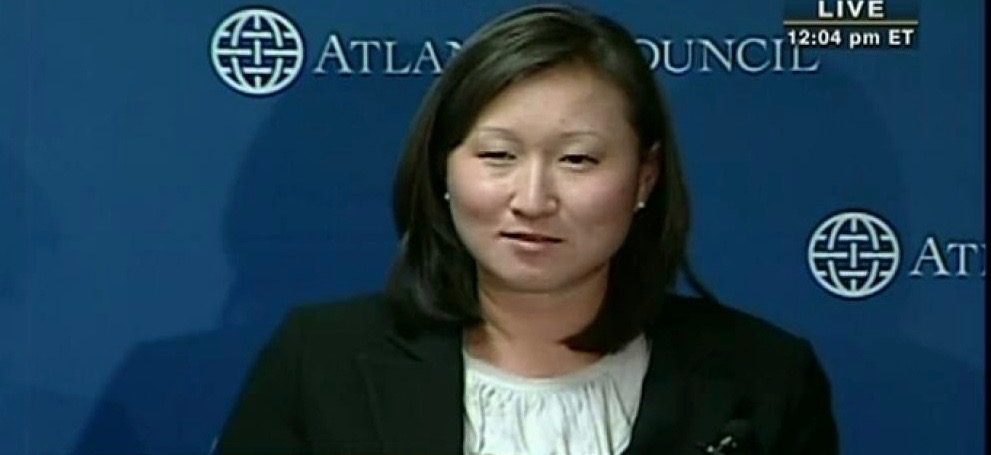
I interviewed the Nr. 2 intelligence official, Kari Bingen at the Pentagon recently. Bingen and I have known each other for more than a decade while she was one of the top space and intelligence staffers on Capitol Hill. She ended her career there as the HASC policy director for the GOP. This is the first interview Bingen has granted since being confirmed two years ago.
A transcript follows:
BD: This is Colin Clark, editor of Breaking Defense. We’re here in the Pentagon today with Kari Bingen, whom I’ve known for far too long, and who is the Number Two person handling intelligence at the Pentagon. We’ll let our readers read your title, which is far too long.
So Kari, let’s start off with the newsiest bit, the fun bit. I don’t think you’ll tell us much, but the Russian’s hypersonic missile apparently exploded during a test. What do we know? What can you tell us, if anything?
Bingen: Sorry, Colin, hate to start out a discussion that way, but I would just say our Intelligence Community is looking at this with all of our capabilities out there and, you probably have to ask the Russian government what’s going on there.
BD: All right. You can tell us about the U-2 flights later. But one of the things that we’ve heard very little about in the last few years is the balance between the military (MIP) and the national intelligence programs (NIP). There was a memo that McConnell and Gates signed ages ago saying that if 51 percent of the money came from the DNI then they ran the program, and vice versa for the Pentagon, which was a huge shift at the time. (Editors note: When the memo was signed, any intelligence program that had even $1 from Pentagon coffers was run by the Defense Department.) How well are you two sides coordinating in the allocation of resources and how do you do it?
Bingen: Yeah, this is an area I’m quite proud of, in the work that we’ve done with (now former) DNI Coats and his deputy, Sue Gordon (who resigned earlier this month). Starting with guidance from the top, as we’ve worked hard over the last couple of years to align our priorities. And I think they’re very well aligned. We issued joint guidance to all of the community annually and we’ve aligned the guidance as well. And then our view is, you know, at the end of the day you have national military intelligence dollars that are taxpayer dollars. So while we have rules of the road for how we collectively contribute those resources, at the end of the day, tax payer dollars have to go to capabilities that support both national and military users. And we’re going to do the best we can to allocate them as such, and then hold ourselves and our components accountable to being good stewards of those dollars.
BD: So when you start out, do you each come to the table with a (budget) number or do you have an intelligence pool of money that you then divide? Cause that’s one of the things that hasn’t really been clear from the outside.
Bingen: Well, we start with our guidance and priorities, and we have all of our agencies and the services come back to us with to plans to execute those priorities — what we think we need for our programs, our personnel, our capabilities. And, you know, if it is, as you know very well, it is an ongoing discussion from the budget bill, to working with OMB to then Congress obviously having a say in this from an authorization/appropriation perspective. So, um, I wouldn’t want to say that there’s anything hard and fast because it’s a negotiation throughout, and there are a lot of cooks in the kitchen. But we do start with, with aligning our priorities and guidance.
BD: So it’s pretty much there, there are close parallels to military requirements generating the budget and then going in and the two sides talk?
Bingen: Absolutely.
BD: Okay. So one of the areas where there seems to be sort of overlap is the National Space Defense Center. It’s NRO, it’s NGA, it’s other intelligence agencies and the Air Force in the Pentagon. I know you’ve been working on those issues for a long time. How are you managing the NSDC budget and its sort of operational side because, with all those different players, it must get fairly messy sometimes. Have you worked out a lot of the wrinkles?
Bingen: Well, I don’t want to say we’re still working them out, but it is a great example of where the Intelligence Community and defense have to come together for a common purpose, whether they are NRO satellites or Air Force or other satellite systems, or even commercial ones. You know, we’re seeing the threat to space grow from other competitors and adversaries. And that threat to space is not solely focused on just Air Force satellites or NRO satellite. So we have to work together for shared mission and shared purpose.
My focus in this area has been on ensuring that we have intelligence capabilities, the expertise to support space operations in a contested environment — everything from understanding what the Chinese and Russians are doing in their R and D space to testing to how they’re deploying capabilities, to how we more effectively operate our own capabilities. In the last many years space has not been considered a war-fighting domain.
Bingen: We are looking at it that way now and that means we have to look at it from a 24/7 operational perspective, like they do with other combat command mission areas. And that’s not something that the Intelligence Community has had to do for the last couple of decades after the end of the Cold War. So, going through and looking at where our really smart scientists and engineers that understand how adversary satellite systems work, to helping to man a 24/7 intelligence operations center with the stand up of Space Command. That’s a different skill set as well. And doing all of the dynamic collection and tasking and exploitation. And real time support to our operators. And that’s an area that we’ve been putting focus on. Ensuring again, we have the right people, the resources, the capabilities to do that.
BD: Now you talked about this at Geoint and we’ve heard from a number of intelligence and military people over the last two years that TPEDS (Tasking Processing Exploitation and Dissemination System) are a huge area of focus for you. Can you give us, without selling the store, an example of something you’ve had to focus on and change? And what’s resulted?
Bingen: A great example of that is what we’re doing with Project Maven, our Artificial Intelligence machine learning initiative. If you were to go to one of our ground stations today where they do all of the processing and exploitation of airborne intelligence and ISR platforms you would see a very linear manual process where we exploited every image. We do a phenomenal job, but there’s just so much data, whether it’s from airborne collectors, satellites, we just don’t have the people — we have really talented people — but we just don’t have enough, enough eyeballs to look at every single image coming through. And it’s again, a very manual process. So that’s where technology, innovation, automation, machine learning, that’s where we need to get to so that we can more effectively sift through all of that data and then do it in a much more dynamic fashion than we are today.
BD: Now, we’ve written a lot about the JAIC, the joint effort to build an AI center. It’s not a program of record. How do you fit in as the Intelligence Community to that effort?
Bingen: It helps that the director of JAIC was a key senior leader within the office of the undersecretary of intelligence and was really the grandfather, the father of Project Maven. So, all of the hard lessons learned about getting artificial intelligence and machine learning out to the field — and I’d love to come back to that –but all of the hard lessons learned of doing it as an intelligence missionary, yet he is now taking those lessons learned and applying it department-wide.
So, whether you’re looking at logistics and predictive maintenance or other challenges that we, the department, have when you’re talking about big data stores, he’s, I think he’s got a great leg up and a great foundation to build off of. So, we absolutely see ourselves plugging into JAIC. We’ve got teams that are working side by side with the JAIC team and obviously the leadership continuity there is key for us. And we’re also working across DoD. I see lines with the AIM initiative (Augmenting Intelligence using Machines) within the IC, because we recognize there’s collaboration there that needs to happen, but AI is just such an emerging area. I wouldn’t even want to pin it on one, one individual, um, one specific admission area because it has such broad applicability across so much of what we’re doing — national security wide.
BD: So do you want to come back to that, something in the field?
Bingen: Oh, yes. Yeah. Thank. Thank you. There was a lot of good development activity happening. I think one of our big pushes in Maven was not just a focus on the development of it, but to get it out to the field. We go off to a lab for years on end and then eventually deliver a warfighter capability five to 10 years down the road. Yes.
BD: If you’re lucky. If.
Bingen: If we’re lucky. Absolutely. And so what we really have been focused on is from the time they got the green light, they got an initial product out into the field within six months for the warfighters to use to tweak, and we’ve just been building incrementally off of that and improving it. Frankly, the operator perspective has made the capability better over time.
BD: So, even though Google dropped out of the contract, you guys were able to get functional stuff in there, which you’re using and obviously working to improve over time. Yes?
Bingen: We’re leveraging over 40 different — I think that was that the last count I saw — 40 different industry partners, Silicon Valley — the whole AI startup community. There was a tremendous amount of talent and innovation out there in the commercial sector that we are absolutely tapping into. And it’s disrupting things. It’s an area that we’re not used to working at and working quickly. And I think they’re also learning what it is to work with the Department of Defense as well, but our key is get something out to the field. That’s where we’re going to make an impact is getting it out to the warfighters
BD: Ethics, we know from the Project Maven debate at Google, was a central issue and Pentagon has been addressing AI ethics from the very beginning. How are you educating these often very small companies that have no experience in the military for the most part, in these often arcane issues with which very few Americans are familiar anymore?
Bingen: Yeah, it’s a good question. And it’s an issue that we take incredibly seriously in the department and we’ve gone, we work from the very beginning when we’re working the requirements piece through development and then deployment to make sure that we have an ethical component to all that we do. And I mean, hopefully, the department’s track record in this area does, um, does highlight this.
We continue to refine our capabilities overall and minimize civilian casualties, work with allies and partners, to provide more precision. And all of that is based on core values and ethics. I do know the JAIC is working on an ethics component, which is one of their foundational pieces to everything that they’re doing there. And we’re obviously working that and leveraging it within Maven, but it was a key aspect that they hit on in their AI strategy that was recently published as well. So, it’s absolutely fundamental to everything that we do. And it’s an area that we, we, I think we do need to have more candid conversations with some of these other new, new innovative companies so they understand how, um, you know, how, how important it is and the responsibility that we, um, that we take it that we take on.
BD: Kari, thank you very much.
Australia unveils ‘historic’ defense boost to 2.4% of GDP in decade, but critics say too little, too late
Part of the shakeup includes tens of billions for nuclear-powered subs, and halting the pricey procurement of an additional F-35 fighter jet squadron.



























